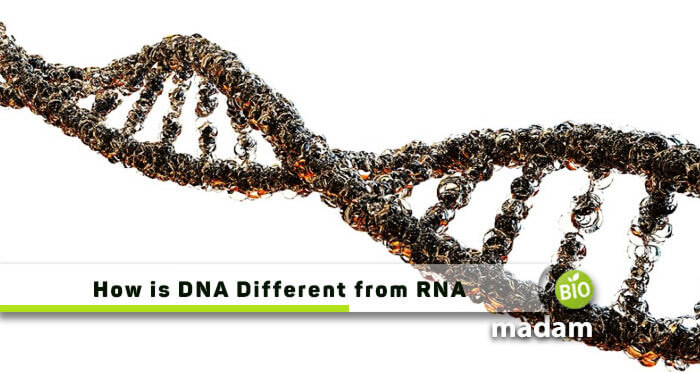All living beings on Earth, whether unicellular organisms like bacteria or multicellular species, e.g., humans, contain genetic material. This material is typically present in the form of nucleic acids, an important class of macromolecules. DNA and RNA are the two primary nucleic acids that carry genetic information from parents to offspring and ultimately bring diversity. Today, we’ll discuss how DNA is different from RNA in detail.
Let’s step ahead toward a brief comparison table between the two!
Comparison Table
| Parameters | DNA | RNA |
| Sugar | Deoxy Ribose | Ribose |
| Helix Structure | Double-Stranded | Single-Stranded |
| Overall Structure | Anti-Parallel | Hairpin & Loop Structure |
| Modification in Bases | Not Modified | Modified |
| Stability | Stable | Unstable |
| Location | Nucleus, Mitochondria | Nucleus, Cytoplasm |
| Processes Involved | Transcription | Translation |
| Polymer Length | Long | Comparatively Short |
| Form of Structure | Preferred B-form | A-form |
| Read As | 3’ to 5’ | 5’ to 3’ |
What is a Deoxyribonucleic Acid – DNA?
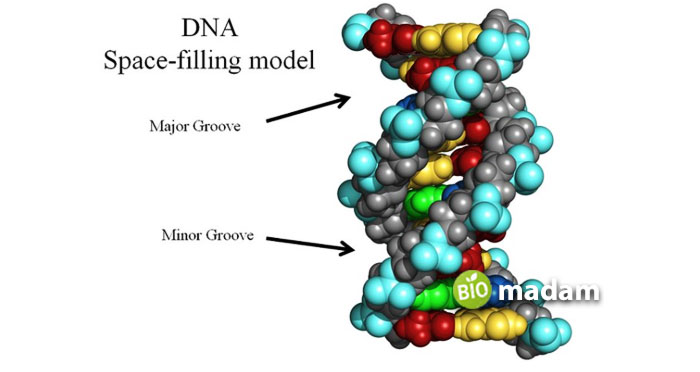
Deoxyribonucleic Acid or DNA is a unique double-helical structure containing genetic information to produce new organisms. This structure is located in eukaryotes and prokaryotes in the form of chromosomes and chromatin. It is also nuclear DNA. The unique hereditary material was initially discovered in 1869 by Swiss chemist Friedrich Miescher. Later on, in 1953, James Watson and Francis Crick explained its structure which is famous under the Watson and Crick model.
DNA is composed of three major building blocks that balance its structure. These are:
Sugar Group (Deoxyribose): Forms the backbone of DNA
Phosphate Group
Nitrogen bases: Adenine (A), Thymine (T), Guanine (G), and Cytosine (C)
This double helix DNA has two nucleotide strands connected by hydrogen bonds. An (Adenine) Pairs up with T (Thymine) through two H-bonds, whereas G (Guanine) and C (Cytosine) are connected through three hydrogen bonds. The sequence of these four nitrogenous bases also called purines and pyrimidines, along the backbone encodes information. One complete turn of the double helix has ten base pairs and is approximately 3.4 nm long.
The DNA is antiparallel, which means that the 5′ ends of one strand is paired with the 3′ ends of its complementary strand (and vice versa). Moreover, the configuration of the DNA molecule is highly stable, allowing it to act as a template for replication, also known as semi-conservative replication. Beside replication, transcription of related RNA molecules also takes place. A primary physical and functional segment of DNA is called gene that codes for the cell’s synthesis of a specific protein is called a gene.
Types of DNA
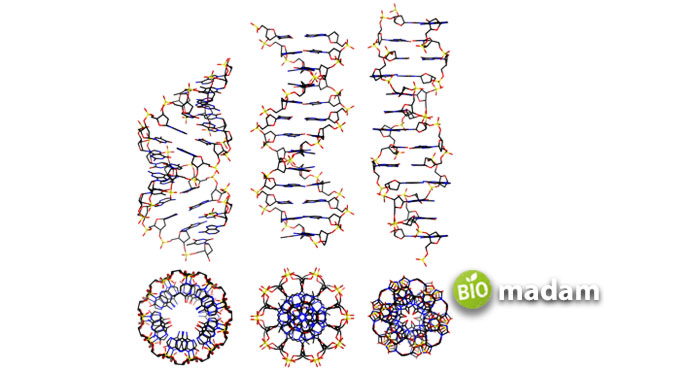
Several DNA types are presently based on structural confirmation. These are:
A-DNA: DNA adopted under the dehydrating condition is a right-handed double helix. A-DNA protects the DNA during extreme conditions such as desiccation.
B-DNA: is the most common and prominent DNA conformation and is a right-handed helix. Most DNA prefers to occur in a B-type conformation under normal physiological conditions.
Z-DNA: is a left-handed DNA confirmation where the double helix winds to the left in a zig-zag pattern. It is found upstream of the start site of a gene and plays a role in regulating gene expression.
Noncoding DNA and Coding DNA
The DNA that doesn’t code for the protein is called noncoding DNA, while coding DNA is responsible for harboring the specific DNA sequences that encode instructions for making proteins. The noncoding DNA is called the regulatory DNA, which determines when and where some genes are transcribed.
Functions of the DNA
DNA is involved in numerous body functions that we’ve enlisted below:
Genetic Material: The genetic/hereditary material carries and stores genetic information.
Replication Process: Transfer genetic information from one cell to its daughters and from one generation to the next with equal distribution during the cell division.
Mutations: The changes in the DNA sequences due to some chemical and physical mutagens.
Transcription: DNA helps in the synthesis of RNA.
DNA Fingerprinting: Laboratory technique used for criminal investigation.
Gene Therapy: DNA also functions to treat or prevent the disease by removing or changing the defective gene.
What is a Ribonucleic Acid – RNA?
Ribonucleic acid (RNA) is another important biological macromolecule present in all cells, carrying the instructions from DNA for protein synthesis. The single-stranded structure of RNA allows this molecule to fold back on itself and form various stable secondary structures like hairpin loops which are stabilized by intramolecular hydrogen bonds between complementary bases.
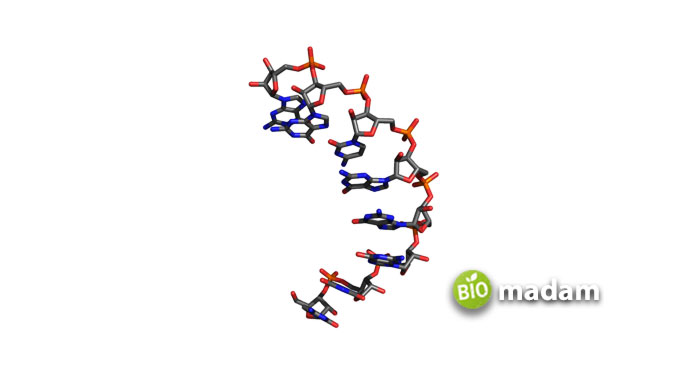
RNA has a similar structure to DNA, but one nitrogenous base out of four is different. These bases are adenine (A), cytosine (C), uracil (U), and guanine (G). In addition, ribose sugar is present in RNA instead of deoxyribose (ribose contains one more hydroxyl group on the second carbon).
RNA is synthesized by the RNA polymerase using the DNA strand as a template through a process known as transcription. RNA can serve as an enzyme itself called ribozyme to perform a catalytic activity in the ribosome. Ribozyme, although being an enzyme, is not a protein. Ribozymes include small nuclear RNAs (snRNAs), and M1 RNA, one of the first known ribozymes.
Types of RNA
There are different types of RNA, and they have different functions in the body.
Messenger RNA (mRNA): It is short, unstable, single-stranded RNA. mRNA carries genetic codes from the DNA in the nucleus to ribosomes in the form of triplets of nucleotides called codons. mRNA comprises 5% of the total RNA.
Transfer RNA (tRNA): Besides being a minor type of RNA, tRNA is an essential translation component. It contains 70-90 nucleotides but is stable with extensive intramolecular base pairing. tRNA has two binding sites – an amino acid binding site and an mRNA binding site. This type of RNA is responsible for carrying the amino acid to the site of protein synthesis in the ribosome.
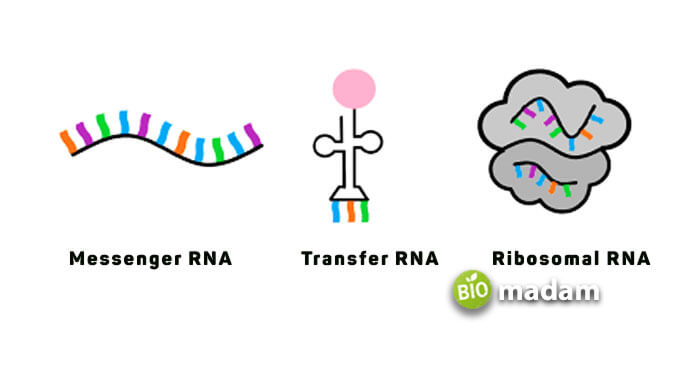
Ribosomal RNA (rRNA): rRNA is a longer, stable molecule composing 60% of the ribosome’s mass and accounts for 80% of the total RNA. The primary function of rRNA is to ensure the proper alignment of mRNA, tRNA, and ribosome during protein synthesis. It catalyzes peptide bond formation between amino acids during protein synthesis.
Functions of RNA
Just like DNA, ribonucleic acid also performs various functions in the body. These are:
- In many RNA viruses, it serves as genetic information.
- RNA is part of the central dogma and is involved in the process of translation.
- The unique Small Interfering RNAs (siRNAs) are important in gene regulation.
- RNA act as a ribozyme.
Differences between DNA and RNA
There are a number of main differences between RNA and DNA that are discussed below:
Abbreviation
DNA
The word DNA stands for Deoxyribonucleic acid.
RNA
Similarly, the word RNA means Ribonucleic acid.
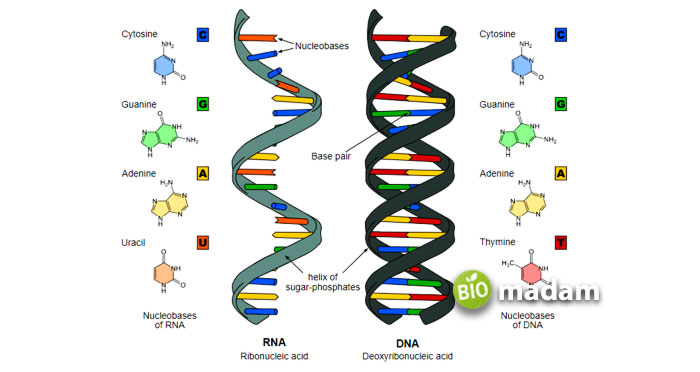
Typical Function
DNA
The double-helix structure is responsible for transferring hereditary material from one generation to another.
RNA
On the other hand, RNA functions to grab information from DNA to make proteins through ribosomes.
Nature of Molecule
DNA
It is a double-stranded polymer, has a long chain of nucleotides, and is usually in B form helix.
RNA
On the contrary, RNA is a single-stranded helix structure consisting of shorter chains of nucleotides and is usually in A form helix.
Location
DNA
Deoxyribonucleic acid is found in the cell organelles with specific functions, such as mitochondria in plant and animal cell.
RNA
In contrast, RNA is found in the nucleus, cytosol or cytoplasm, and ribosomes.
Nitrogenous Bases
DNA
The base pairing within the DNA is G≡C (Guanine with Cytosine) and A=T (Adenine with Thymine).
RNA
Likewise, RNA’s base pairing is G≡C (Guanine with Cytosine) A=U (Adenine with Uracil).
Stability in Alkaline Environment
DNA
DNA is pretty stable in basic/alkaline conditions.
RNA
However, on the opposite, RNA shows instability in an alkaline environment.
Replication
DNA
This polymer can replicate itself through DNA polymerase. The DNA replication process differs in prokaryotes and eukaryotes.
RNA
On the other hand, RNA doesn’t replicate on its own. DNA synthesizes it with the help of RNA polymerase.
UV Damage
DNA
A deoxyribose molecule is easily susceptible to UV damage.
RNA
In contrast, RNA is relatively resistant to UV damage.
Final Verdict
Both DNA and RNA play a vital role in the body, as we’ve seen above in detail. The 2’ OH group in the pentose sugar of RNA makes it more reactive compared to DNA. However, deoxyribose sugar has significance. Life is impossible without the double-helix DNA structure in multicellular living beings.

Anna has completed her degree in Pharmacy from the University of Hawaii. She is serving as a research assistant in a pharmaceutical company. She had a great interest in writing blogs, traveling to different parts of the US, and trying delicious recipes in her spare time.

